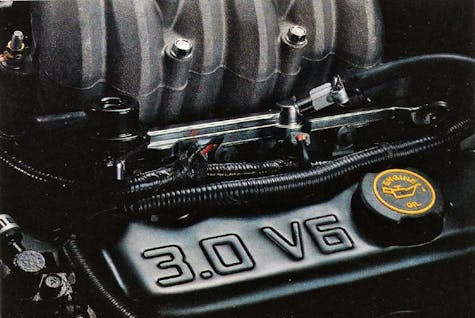Piston Slap: What makes a reliable engine?

Lyle writes:
Hey Sanjeez, I have a question for Piston Slap: What makes a reliable engine?
Like, there are some throughout history that seem to have endlessly positive reputation despite having at least some problems or quirks. Nothing is perfect, but why are some better than others? Is it the design? Production? Materials? Some combination of all three, with a little sprinkling of Chemical X?
Sanjeez (who is really Sajeev) answers:
Excellent question Lyle, and your slow meatball pitch is setting me up for a home run. Thanks for that, so let’s get into why a combination of everything you mentioned makes a reliable engine.

I learned that even the most durable motors have problems at some point in vehicle ownership, stemming from faults in engineering or the supply chain. Even worse, this can happen at any time over the engine’s lifecycle, because it’s just a commodity made by a multi-national corporation. I used to think the 100 percent cast-iron Ford Vulcan V-6 was as tough as they get, except examples at the tail end of its 20+ year history had a defective cylinder head casting that could crack.
My tarnished brand loyalty aside, it turns out that everything matters, especially over time. Cheap out in the supply chain (somewhere, who knows where) and something like this cylinder head defect surfaces. Add the complexity of modern small displacement, low friction turbocharged engines designed to meet government mandates across the globe, and the system is ripe for failures.
And no period of time is safe from blame: Bite off more than you can chew with bleeding edge technology and the early Cadillac HT4100 engine is the result. Tinker with oil change intervals, PCV systems, etc., and sludgy 2000s era motors from VW and Toyota rise to the surface. Subaru boxers have a serious love/hate relationship with the Internet. And when the entire industry seeks less friction in an engine’s short block, oil consumption issues across the board becomes more prevalent.
Now let’s get a little weird …
Chasing down all the fail points will drive you mad, but as a judge in the 24 Hours of Lemons, I learned that presumably durable mills can be downright hapless in endurance races. I’m looking at you, small-block Chevy and various engines from Toyota and Honda that can’t stand being revved for long periods of time. Even the legendary Chrysler Slant-Six has a checkered history in this series, while BMW inline-sixes can take the heat just as well as they do on the streets. (Maybe better?)
Ironically and shockingly, Lemons taught us that the Cadillac HT4100 does pretty well in an endurance race. A Cadillac-swapped Miata is winning races fast enough to hurt some egos in the process. Contrary to the delightfully snarky video above, the HT4500 and HT4900s are one of the better V-8 swaps you can do in this race series. Getting a budget-built small-block Ford/Chevy to be competitive for that many hours on track is difficult, but aside from Ford’s lazy-revving SOHC 4.6-liter mill, the Cadillac is where its at.
And oh boy, does it ever have Cadillac style! (Cue that bass guitar drop!)
I think everyone needs an HT4100 swap so they can go and “live, love every mile” in flagship style. It proves the point that good engines can be junk, and junky engines can be fantastic.
Frustrated by my answer yet?
Just remember that nothing is sacred, as engineers, mechanics, previous owners, government mandates, and supply chain snafus will find a way to surprise you. No brand is unassailable, no dataset has all the information you seek. So be vigilant on maintenance, buy used vehicles with a service history, and get an extended warranty if your nerves cannot be soothed into submission. Only joking on that last part … probably.
Have a question you’d like answered on Piston Slap? Send your queries to pistonslap@hagerty.com—and give us as much detail as possible so we can help! Keep in mind this is a weekly column, so if you need an expedited answer, please tell me in your email.
***
Check out the Hagerty Media homepage so you don’t miss a single story, or better yet, bookmark it. To get our best stories delivered right to your inbox, subscribe to our newsletters.


Damn, nobody mentioned the Mercedes OM 615,616,617 diesels. Those are pretty much legendary in terms of engineering, design, top quality supplier components and longevity even with less than stellar maintenance. I started with and worked for MB for 14 or so years as a mechanic before going to the dark side of Ferrari and Maserati which brings me to the one that’ll blow all your minds…the F136 Ferrari/Maserati V8 (read F430 and Quattroporte and GranTurismo) must be one of the best gas V8s ever built. I’ve since spent and equal number of years with the goombas and I have to say, that V8 (with the ONE exception of timing variators on early wet sump engines) is literally bulletproof. We simply don’t have any issues with them…none, nada, zip. No rough running, no overheating, no oil consumption, literally nothing. Was and is just a brilliant engine all around. My own 2007 Quattroporte Sport GT Automatica which I acquired when it was 3 or 4 years old is now quickly closing in on 200K trouble free (and I mean 100% trouble free) miles. And backed with the ZF6, it makes for a driveline that not only sounds spectacular but has a dead reliable tranny behind it. The Maseratis to use this engine will be the 2007-2013 QP and 2008-2018 GT (all variants). And in the Ferrari application (F430) it’s equally as reliable internally.